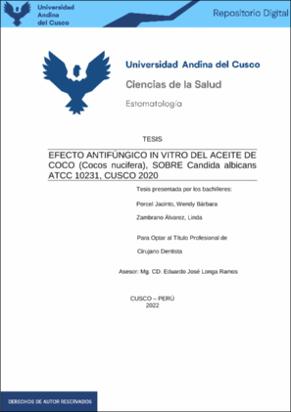| dc.contributor.advisor | Longa Ramos, Eduardo José | |
| dc.contributor.author | Porcel Jacinto, Wendy Bárbara | |
| dc.contributor.author | Zambrano Álvarez, Linda | |
| dc.date.accessioned | 2023-04-21T15:03:03Z | |
| dc.date.available | 2023-04-21T15:03:03Z | |
| dc.date.issued | 2022-12-06 | |
| dc.identifier.uri | https://hdl.handle.net/20.500.12557/5388 | |
| dc.description.abstract | La presente investigación tuvo como objetivo evaluar la efectividad antifúngica in
vitro del aceite de coco (Cocos nucifera) sobre Candida albicans. MATERIAL Y
MÉTODO: Metodológicamente el trabajo de investigación tiene un enfoque
cuantitativo es de tipo experimental in vitro de ámbito laboratorial. Se trabajó con
un muestreo no probabilístico por conveniencia, por lo que se decidió la
utilización de 30 placas Petri contenidas con la cepa Candida albicans, la cual
fue reactivada con agar Sabouraud, cada placa contó con un disco de difusión,
haciendo un total de 30 muestras para luego ser colocados los discos embebidos
con aceite de coco en sus diferentes concentraciones y ser incubadas a una
temperatura de 37 ͒C durante el resto de la investigación y fueron retiradas de la
incubadora únicamente para medir los halos de inhibición generados a partir de
las 24, 48 y 72 horas , determinando su sensibilidad de acuerdo a la escala de
duraffourd.
Se utilizó la técnica de observación y como instrumento una ficha de recolección
de datos, el procesamiento estadístico de datos se realizó con el programa SPSS
21.
RESULTADOS: Se llegó a los siguientes resultados según la prueba de U de
Mann-Whitney para muestras independientes, se obtuvo halos de inhibición
promedio de 0.0 mm,
5.9 mm y 22.0 mm para las concentraciones del 25
%, 50 % y 100 % respectivamente; y para el control positivo con fluconazol de
150 mg se obtuvo un halo de 23.6 comparando las diferentes concentraciones
del aceite de coco con el control positivo se puede decir entonces que el fluconazol tiene una mejor eficacia para inhibir el crecimiento de la Cándida a
comparación del aceite de coco que demostró tener un menor efecto.
CONCLUSIÓN: Se concluye que cuando el tiempo de exposición es de 24 horas,
se tienen mejores resultados, siendo el valor promedio de 21.3 mm a una
concentración del 100%, mientras que a las concentraciones de 25% y 50% no
resultó efectivo ya que los halos de inhibición obtenidos tuvieron un diámetro
menor a 9 mm quiere decir que es resistente según Duraffourd. | es_PE |
| dc.description.abstract | The objective of this research was to evaluate the in vitro antifungal effectiveness
of coconut oil (Cocos nucifera) on Candida albicans.
MATERIAL AND METHOD: Methodologically, the research work has a
quantitative approach and is experimental in vitro in a laboratory setting. Non-
probabilistic convenience sampling was used, so it was decided to use 30 Petri
dishes containing the Candida albicans strain, which was reactivated with
Sabouraud agar, each plate had a diffusion disk, making a total of 30 samples to
then be placed discs embedded with coconut oil in its different concentrations
and incubated at a temperature of 37 ͒C during the rest of the investigation and
were removed from the incubator only to measure the inhibition halos generated
from 24 , 48 and 72 hours, determining its sensitivity according to the Duraffourd
scale.
The observation technique was used and a data collection sheet as an
instrument, the statistical data processing was carried out with the SPSS 21
program.
RESULTS: The following results were obtained according to the Mann-Whitney
U test for independent samples, average inhibition halos of 0.0 mm, 5.9 mm and
22.0 mm were obtained for concentrations of 25%, 50% and 100% respectively.
; and for the positive control with 150 mg fluconazole, a halo of 23.6 was obtained
comparing the different concentrations of coconut oil with the positive control, so
it can be said that fluconazole has a better efficacy in inhibiting the growth of
Candida compared to the oil. coconut which was shown to have less effect.
CONCLUSION: It is concluded that when the exposure time is 24 hours, better
results are obtained, being the average value of 21.3 mm at a concentration of 100%, while at concentrations of 25% and 50% it was not effective since the
inhibition halos obtained had a diameter of less than 9 mm, which means that it
is resistant according to Duraffourd. | en_US |
| dc.format | application/pdf | es_PE |
| dc.language.iso | spa | es_PE |
| dc.publisher | Universidad Andina del Cusco | es_PE |
| dc.rights | info:eu-repo/semantics/restrictedAccess | es_PE |
| dc.rights.uri | https://creativecommons.org/licenses/by-nc-nd/4.0/ | es_PE |
| dc.subject | Cocos nucifera | es_PE |
| dc.subject | Antifúngico | es_PE |
| dc.subject | Candida albicans | es_PE |
| dc.subject | Aceite de coco | es_PE |
| dc.title | Efecto antifúngico in vitro del aceite de coco (cocos nucifera), sobre candida albicans atcc 10231, Cusco 2020 | es_PE |
| dc.type | info:eu-repo/semantics/bachelorThesis | es_PE |
| thesis.degree.name | Cirujana Dentista | es_PE |
| thesis.degree.grantor | Universidad Andina del Cusco. Facultad de Ciencias de la Salud | es_PE |
| thesis.degree.discipline | Estomatología | es_PE |
| dc.publisher.country | PE | es_PE |
| dc.subject.ocde | https://purl.org/pe-repo/ocde/ford#3.02.14 | es_PE |
| renati.advisor.dni | 29335747 | |
| renati.advisor.orcid | https://orcid.org/0000-0002-1974-8321 | es_PE |
| renati.author.dni | 73021344 | |
| renati.author.dni | 43097996 | |
| renati.discipline | 911016 | es_PE |
| renati.juror | Arenas Fernández Dávila, Jesús Alejandro | |
| renati.juror | Cabrera Cuentas, Rocio | |
| renati.juror | Alanya Ricalde, José Antonio | |
| renati.juror | Fluker Gallegos, María Luisa | |
| renati.level | https://purl.org/pe-repo/renati/level#tituloProfesional | es_PE |
| renati.type | https://purl.org/pe-repo/renati/type#tesis | es_PE |



